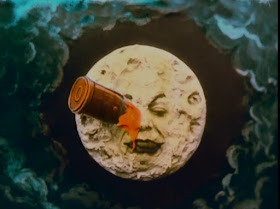
As Serge Bromberg pointed out, he is engaged not only in the business of restoring films, but also of restoring audiences. The catalogue of his Lobster Films is superb, constantly swelling with newly restored titles, and Bromberg shares them with zeal. He was an entertaining host throughout the TCM Festival weekend.
The jewel of Sunday morning’s program was the recently restored, original hand-colored version of Méliès’s Le Voyage dans la lune (1902). The colored version had long been presumed lost; it turned up in 1993, but fused into basically a solid disc in the canister. A certain amount was done to try and rescue it chemically, but Bromberg had to wait until 2010 for the digital technology to evolve that would allow for an actual restoration. 95% of the original coloring was saved, the rest seamlessly filled in (13,375 frames in total), and a splendid accompaniment commissioned from Air. Even in black and white, it is a film that never ceases to astonish; the pristine, vivid colors take it to a whole new level.

The rest of the program followed the subtitle loosely enough to include Keaton’s The Love Nest (1923), which had been restored from four different prints; and Méliès’s only “erotic” film, Après le bal (1897), which features his muse Jeanne d’Arcy being undressed and bathed by a maid (in flesh-toned underwear, from beneath a huge quantity and variety of other undergarments). There was also a rather awkward Caruso imposter, miming to an actual Caruso recording, in an interesting early sound experiment; and some weird microphotography in The Acrobatic Fly (1907). Insects recurred in a rather fun and beautifully-colored 1906 Pathé offering, La peine du Talion, in which ladies dressed as various butterflies and crickets take appropriate revenge on a loud-coated entomologist.


The most amusing offering was one that promised the Japanese Kiriki troupe of acrobats, visiting France in 1905. They file onscreen beneath a lattice arch, bow solemnly, and commence to arrange themselves into literally gravity-defying acrobatic formations. Cutting from the introduction, the camera seamlessly placed in a bird’s-eye view position, and the lattice arch and the acrobats lay on the floor, turning somersaults to “stand” on one another’s shoulders, or more usually, assume postures that would be completely impossible rightways up. To disguise the trick further, the film is also played backwards. This is charming and amusing to us today, but must really have been mind-boggling to the early audience.

The program opened with the celebrated A Trip Down Market Street. This was shot in April 1906, four days before the San Francisco earthquake. The Miles brothers put a camera in the front of a streetcar and just let it run. The tower of the Embarcadero looms gradually larger; the wide, cobbled street is lined with tall, handsome buildings; and it is thronged with horses and carts, a number of automobiles, and milling pedestrians. Some turn and stare; others scurry between the traffic, which seems unencumbered by any specific rules of the road. The unbroken 13 minute take is hypnotic, cinema as time travel, or a repository of lost worlds. It was followed by a sobering snippet, filmed in San Francisco just days later: a travelling camera takes us past the ruins, mostly razed to rubble, dotted with the occasional still-standing shell of a building. It is barely recognizable as a city, never mind the one we just saw.

No comments:
Post a Comment